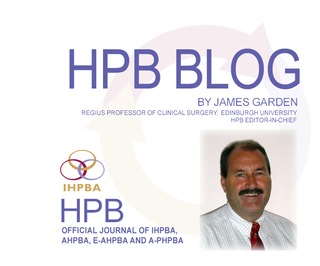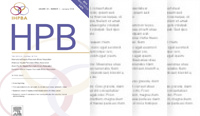International Hepato-Pancreato-Biliary Association
HPB Blog, January 2015

So another New Year for HPB and an exciting one for our readership. Thank you for all your continued support and for making the journal increasingly successful and THE journal for those of us who wish to be kept up to speed on the latest evidence and developments in our specialty. This month, we have our talented assistant editors, Rebecca Minter and Ewen Harrison, assisting me with the highlights. These flag the challenge of managing neuroendocrine liver metastases for which the evidence base is poor. January’s issue presents some additional guidance for a patient population that are often asymptomatic despite an extensive tumour burden.
Three review articles resulted from a consensus conference held by the E-AHPBA in London in 2012. There was excellent attendance at this meeting demonstrated the thirst for new evidence since much of what is published is repetitive, anecdotal and of a low level of evidence. The systematic review by Lesurtel and colleagues highlights this very fact. Of 1594 reports available for review, only 38 were relevant for analysis. Remarkably only two of these focused on quality of life issues. They found little evidence to support debulking of liver metastases or to suggest that liver resection was better than other liver directed therapies. Eighteen of the 115 papers considered to be of relevance by Kennedy et al, showed that intra-arterial therapy is used extensively and that embolization is generally well tolerated, but again, there is little reliable evidence to suggest that it has impact on survival. The review notes increasing interest in radioembolisation but its popularity is again not necessarily evidence based. So what about taking the liver out and replacing it? Fan and his colleagues reviewed an extensive database and established that the 706 patients who were recorded as having undergone liver transplantation for disease confined to the liver had done well with a 70% five year survival. This is good news for those few selected patients worldwide. However, the observation that patients with tumours that are not poorly differentiated and that have been assessed over a period of at least 6 months will benefit most would suggest that this is not a mode of treatment that can be readily extended. Furthermore, such patients will generally do well if merely observed, so are we really any further forward?
Ewen Harrison meantime took a deeper look at the variability in the reported rate of complications following liver resection and stressed that this may partly be due to differences in definitions. Of the definitions now published in three areas by the International Study Group for Liver Surgery (ISGLS) has now published definitions in three areas, bile leak is the one investigated in HPB. Brooke-Smith and his ISGLS colleagues used their definition and grading system to prospectively evaluate bile leakage after liver resection. Of 949 patients in 11 centres undergoing liver resection for predominately colorectal liver metastases, 7.3% were diagnosed with a bile leak. Of these, just over half required something done about it. He noted that grade A bile leaks requiring no or little change in patients’ management are only diagnosed in the presence of an abdominal drain. In those with such apparently inconsequential grade A bile leaks, a greater number and severity of other complications were seen, together with a longer hospital stay (median 14 versus 7 days on average). Indeed, bile leak was significantly associated with intra-operative blood loss which may explain these poor outcomes. Ewen picked up that although there is little strong evidence to support drainage after liver resection, this series reported use of drains in two thirds of patients. In nearly half of patients with a bile leak and a drain, there was no significant change in the clinical course. The authors rightly suggest that up to 94% of patients did not benefit from intra-operative drainage. Furthermore the overall complication rate of 38% is striking. Although only 8.8% of complications were classified as severe, this rate is not improving. Interventions to reduce this rate should surely be a priority in seeking to improve long-term liver resection outcomes.
Rebecca Minter focused on a group of patients that the HPB surgeon likes to see, those with the more favourable biology of ampullary adenocarcinoma. Amini and colleagues report the results of a population level study assessing the impact of performing local resection alone for T1 ampullary adenocarcinoma utilizing the Surveillance, Epidemiology, and End Results (SEER) database. Of 421 eligible patients with T1 disease, 21 (5%) patients underwent local resection alone, while 20 (5%) patients were treated with ampullectomy and regional lymphadenectomy, and 163 (39%) patients with pancreaticoduodenectomy (PD). Interestingly, 217 patients (51%) did not undergo resection of any kind, resulting in a median survival of only 16 months. In patients who underwent concomitant lymphadenectomy, metastatic lymph nodes were present in of 20% of patients which is 20 consistent with previous studies. She stressed that even patients with well-differentiated histology, who would be potentially the best candidates to consider for local resection alone, had metastatic lymph nodes present 10% of the time. The addition of regional lymphadenectomy, either concomitant with local resection or with PD, for T1 ampullary adeno-carcinoma improved survival significantly regardless of lymph node status as compared to local resection alone. There seems little sense to pursue endoscopic ampullectomy for T1 lesions in fit patients. However, endoscopic ampullectomy may still offer a significant survival advantage for the un fit patient since median survival with local resection alone was 55 months. The finding that 51% of patients are treated with surveillance alone in this population based study may represent an opportunity for intervention with positive benefits for patients with this disease that are presently unrealized.
So, lots of interesting content in HPB to start 2015. Keep sending us in manuscripts and fulfil my New Year wish that we have an impact factor greater than 2.5 by the summer!
James Garden
Click here for the Table of Contents
Corporate Partners
If you are interested in becoming a Corporate Partner of the IHBPA please contact industry@ihpba.org
Find out more


